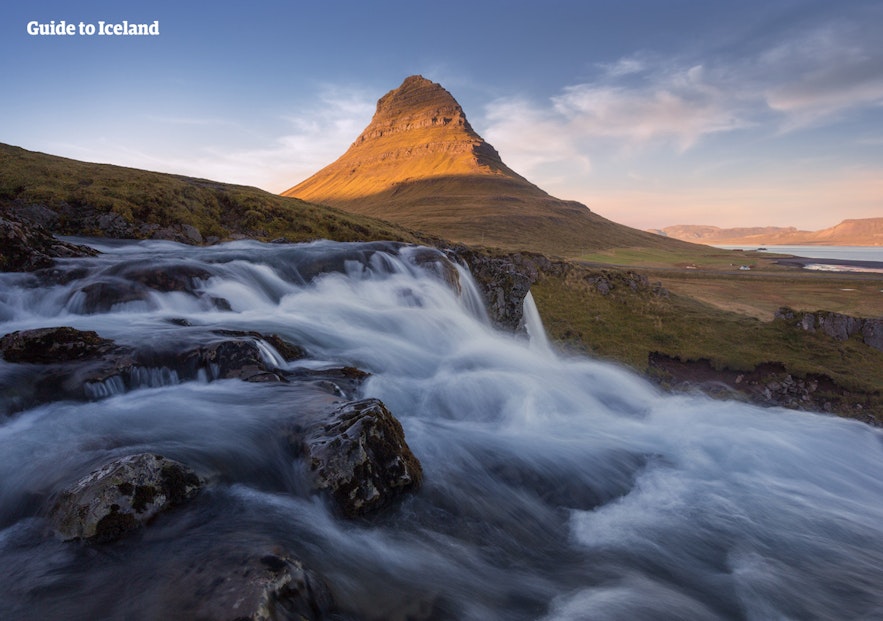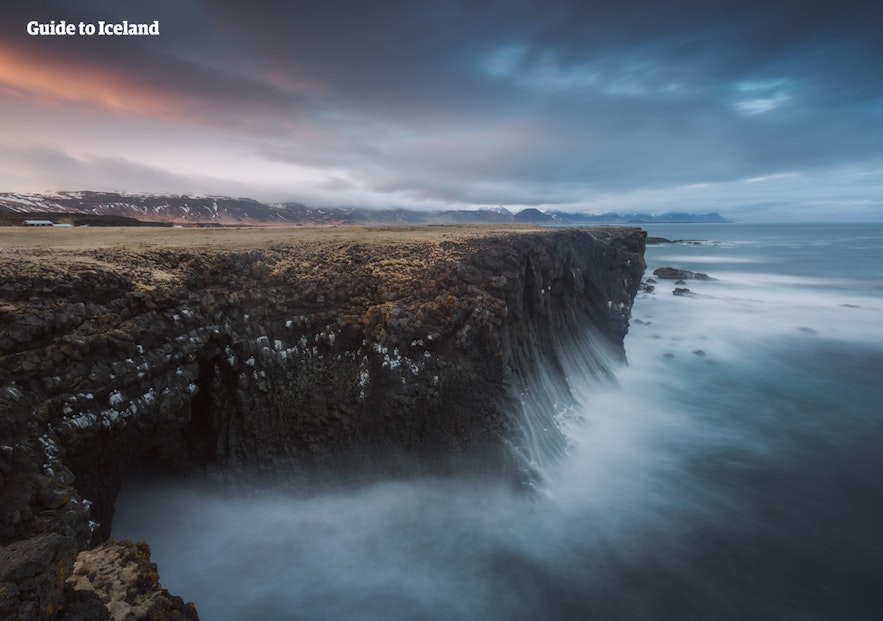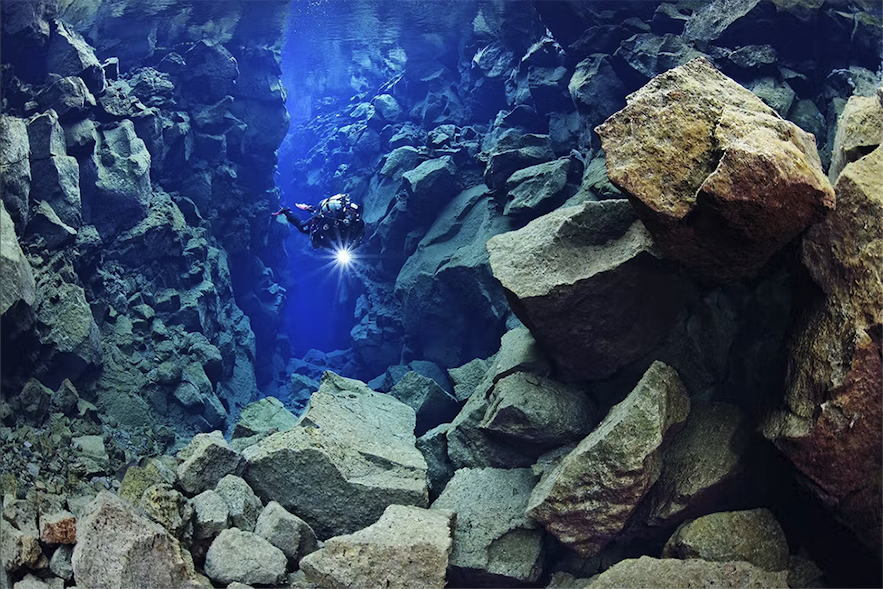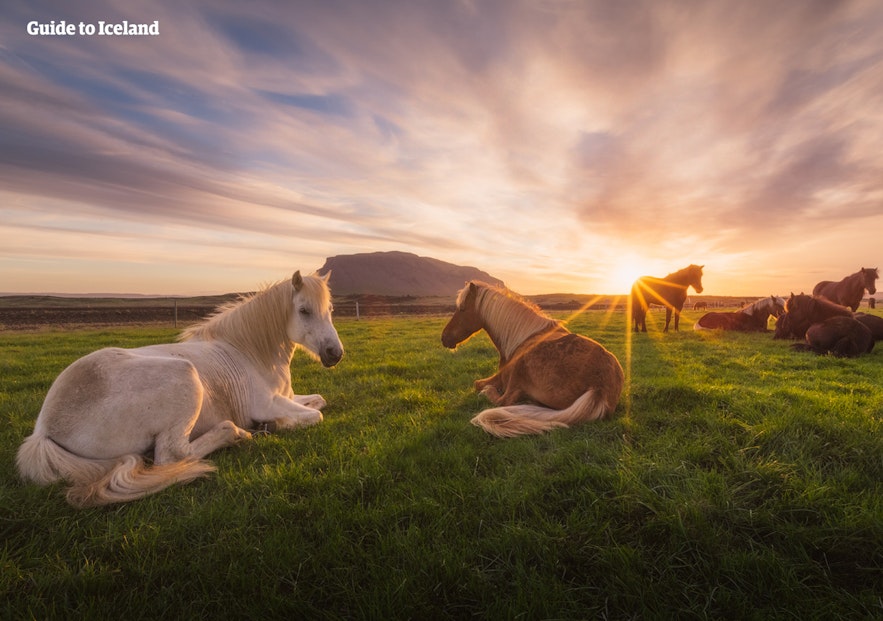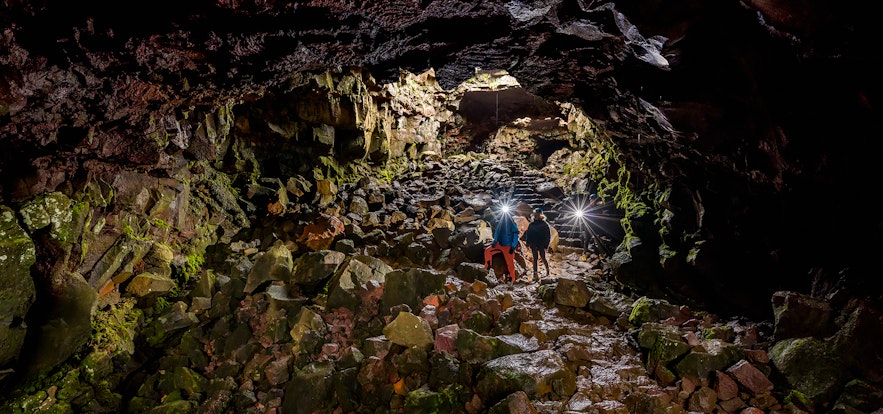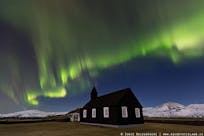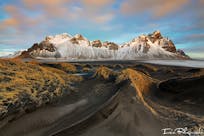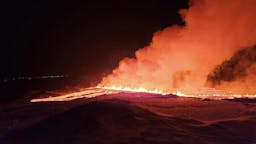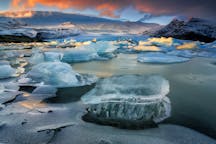
Visiting Iceland in May | Things to See & Do
- Is May a Good Time to Visit Iceland?
- Weather in Iceland in May
- Is Iceland snowy in May?
- Daylight in Iceland in May
- Chasing the Midnight Sun in Iceland in May
- What to Wear in Iceland in May
- Best things to do in Iceland in May
- Hot Springs and Swimming Pools in Iceland in May
- Diving and Snorkeling in May in Iceland
- Hiking in May in Iceland
- Exploring Glaciers in Iceland in May
- Glacier Hiking in Iceland in May
- Snowmobile Tours in Iceland in May
- Fishing in Iceland in May
- Horseback Riding in May in Iceland
- Lava Caving in Iceland in May
- Whale Watching and Bird-Spotting in May in Iceland
- Puffin Tours in May in Iceland
- Can you see the Northern Lights in Iceland in May?
- Best things to do in Reykjavik in May
- The Golden Circle tour from Reykjavik in May
- Geothermal spas near Reykjavik open in May
- The Reykjavik Food Tour in May
- Hotels in Reykjavik in May
- Driving around Iceland in May
- Can I rent a car in Iceland in May?
- Can you drive the Ring Road of Iceland in May?
- Can you drive to explore the Golden Circle in May?
- Events in Iceland in May
- Ascension Day (Public Holiday)
- Famous churches in Reykjavik
- RAFLOST: Icelandic Festival of Electronic Arts
- International Day of the Icelandic Horse
- May First (Labor Day)
- Should You Visit Iceland in May, April, or June?
- Recommended travel itineraries for May
Discover why traveling to Iceland in May is a great choice for your next vacation. Learn about the weather in Iceland during May and what activities you can engage in while visiting. So read on and explore the best things to see and do in Iceland in May.
In May, the chill of winter is easing off, and daylight lasts longer. A lot of tours and excursions are opening up, giving visitors plenty of opportunities to see what Iceland has to offer. There is a wide selection of May tours in Iceland that you can be a part of, such as visiting the famous Blue Lagoon or going horseback riding in the Icelandic wilderness.
For the ultimate freedom while exploring the land of ice and fire, we recommend renting a vehicle at Iceland's largest rental car marketplace so you can travel from place to place with ease. Go here to read about Spring in Iceland.
Is May a Good Time to Visit Iceland?
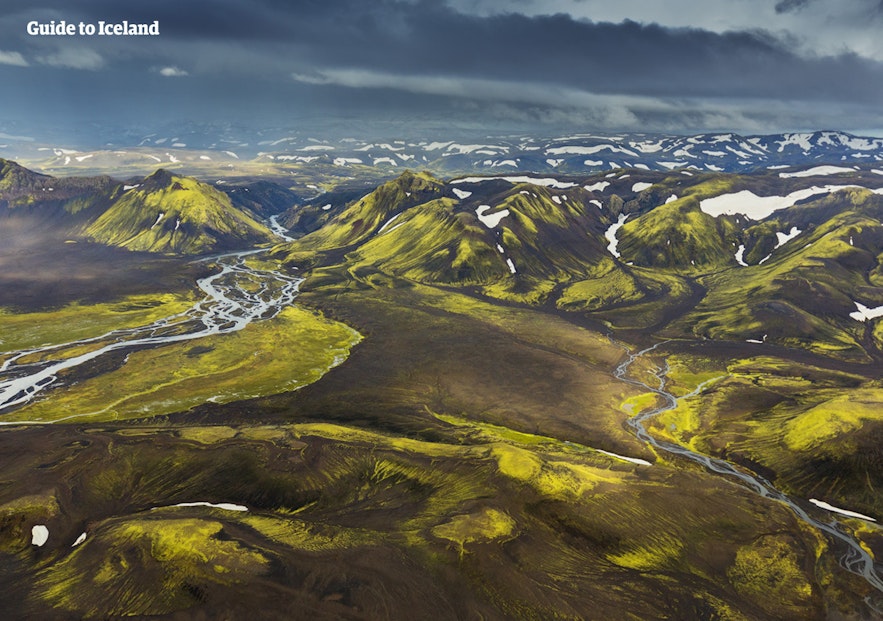
You won't have a problem finding great accommodations in Iceland all over the country, whether you're looking for a luxury hotel or wanting to rent a cottage in the nature of Iceland.
Weather in Iceland in May
Iceland's weather in May is generally fair. The worst of winter has passed, and you can expect a better chance of blue skies and sunshine. That doesn’t mean Iceland can't be a bit chilly in May. Average temperatures range from 2 C (36 F) to 11 C (53 F).
- See also: Weather in Iceland & Best Time To Visit
But there is a big difference depending on when in the month you visit in May. The weather gets warmer as the month goes on. The average temperatures in early May are around 2 C (36 F) with 18 daylight hours. In late May, the average temperature is around 11 C (53 F) with 20 daylight hours.

Is Iceland snowy in May?
The weather in Iceland is quite unpredictable, but usually, in May, it stops snowing. Even though the Icelandic weather is known for varying from bright sunshine to hail storms throughout the course of one day. That said, by May, the likelihood of snowfall is exceptionally low. Some mountain tops are still white and snowy, so you could experience some climbing high up in the mountains.
Daylight in Iceland in May
In early May, the sun rises at 5 AM and sets at 10 PM. By late May, the sun rises at 3:30 AM and sets at 11:30 PM, meaning there are only 4 hours of darkness. The result is that it never actually gets fully dark, which is why you can’t see the northern lights in May.
Chasing the Midnight Sun in Iceland in May
As the month of May progresses, the longer hours of daylight mean that come late May, you’re getting close to experiencing Iceland’s famous midnight sun.
- See also: Midnight Sun in Iceland
During this period, you can get some amazing pictures of Iceland. The lingering sun and clearer skies — not to mention fewer travelers — make May an excellent time to capture beautiful scenic photographs of Iceland.
What to Wear in Iceland in May
As the weather can fluctuate so much, it’s recommended that you pack for every type of climate when you visit Iceland in May. You will need a mixture of warm and waterproof clothing, along with some lighter spring apparel.
Our recommended packing list for clothes to take when visiting Iceland in May
- A water- and windproof jacket
- Sturdy hiking boots
- Fleece and other layers
- Plenty of socks
- Scarves, hats, and gloves
- Sunglasses
- Swimsuits
- Cap
The weather in Reykjavik tends to be a little warmer than in the rest of the country. So if you’re only visiting the capital and the surrounding area, you might get away with fewer winter clothes.
Best things to do in Iceland in May
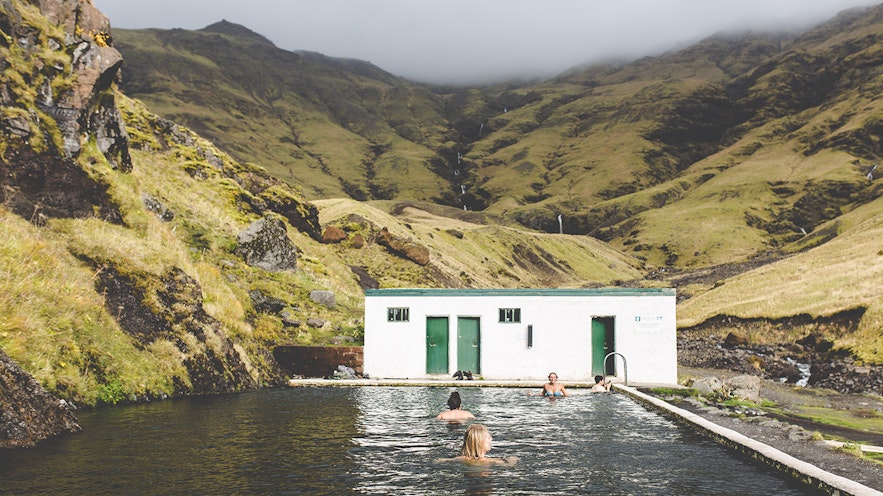 Visiting Iceland in May means you'll have the opportunity to participate in many activities, ranging from the cultural and relaxing to the exciting and adrenaline-fuelled.
Visiting Iceland in May means you'll have the opportunity to participate in many activities, ranging from the cultural and relaxing to the exciting and adrenaline-fuelled.
- See also: The Ultimate Guide to the Golden Circle
Though some regions of the country are still inaccessible—such as the Central Highlands—many experiences are still available as the summer months roll in.
Some of the tours you can be a part of include whale watching, snorkeling, scuba diving, ATV trips, horseback riding, lava caving, glacier hiking, mountain biking, and sightseeing; the list is endless. And the longer daylight hours can turn Iceland into a non-stop adventure in May!
There are also several Icelandic festivals and public holidays in May.
Music lovers can go to the RAFLOST — the Icelandic Festival of Electronic Arts. While animal lovers can join in the celebrations of the International Day of the Icelandic Horse.
Read on to check out what to see and do in Iceland in May!
Hot Springs and Swimming Pools in Iceland in May
Hot springs are Iceland's more popular summer attractions. Despite the difference in surroundings and temperature, Iceland's many geothermal pools are not only good for a relaxing soak but also beautiful to visit.
As opposed to hunting for hot springs in the winter — which involves sub-zero temperatures — the May weather in Iceland is considerably milder.
There are many great geothermal spas all around the country with modern amenities and luxury treatments that visitors can engage in.
With so many hot spring pools scattered across the landscape, they can sometimes be difficult to find. Be sure to find out where the pools are before you set out.
Be mindful that if you want to bathe in natural hot springs, some of the springs in Iceland are on private land and require permission from the landowner to enter. Ask locals for recommendations, or join a hot springs tour to find the best spots and ensure you don’t get lost.
 If you prefer a more luxurious spa experience, you can visit one of the country’s many swimming pools. Reykjavik alone has over 17 public swimming pools!
If you prefer a more luxurious spa experience, you can visit one of the country’s many swimming pools. Reykjavik alone has over 17 public swimming pools!
Iceland’s swimming pools are more than just a pool to swim laps in, they usually have saunas, steam rooms, and multiple hot tubs. They’re a great way to get rid of jet lag and start your holiday with some relaxation.
One of the most popular and accessible public swimming pools for visitors is Laugardalslaug in Reykjavik. Aside from geothermal hot tubs, the pool offers water slides, a steam room, and sauna, a gymnasium next door, an Olympic-sized swimming pool, and an area for kids to play. There’s also a shallow, heated pool perfect for stretching out and chilling in the sunshine. The water slide also has no upper age limits (after all, you're never too old!).
Make sure you’re aware of the rules regarding local public pools, though. In Iceland, it's required to shower naked before entering the water. This helps stop the spread of bacteria and keeps the water clean.
Diving and Snorkeling in May in Iceland

You can also go snorkeling or even diving in Iceland in May. The UNESCO World Heritage site, Thingvellir National Park, is 29.5 miles (47.5 kilometers) east of the capital and is home to one of the top diving and snorkeling sites in the world: the Silfra fissure glacial gorge.
Crystal-clear water runs from the Langjokull glacier to the fissure through the Mid-Atlantic Ridge's underground network, which takes up to 50 years. Because of this, the current in the Silfra fissure is weak, which means it’s easy to swim in.
It’s important to note that snorkeling and scuba diving trips at Silfra do have some requirements to ensure everyone’s safety:
- You must be over 16 years old
- The minimum height is 5 feet (150 centimeters)
- The minimum weight is 100 pounds (45 kilograms)
- You must be physically fit, able to swim, and not pregnant
Scuba diving in Silfra fissure has more requirements:
- Participants must be certified PADI open-water divers with proof of dry suit experience within the last 2 years.
- The minimum age is 17, though all those under 18 years old require a written consent slip from their legal guardian.
- Participants must also sign a liability and a medical form before entering the water.
- See also: Diving and Snorkeling in Iceland
The Thingvellir National Park is an important location to Icelanders for several reasons.
First, it’s where one of the first national assemblies in the world, the Althingi, was founded. The modern parliament is now located in Reykjavik, but Althingi started at Thingvellir over 1,000 years ago. Guests today can walk right up to where these historical gatherings were once held.
The second reason is its geology. Thingvellir National Park is one of the only places on the planet where you can see both the North American and Eurasian tectonic plates at the same time.
Photo from Incredible 3-Hour Guided Drysuit Diving Tour in Silfra with Hot Drinks
Some scuba diving operators also travel to other dive sites, such as the nearby Davidsgja (David’s Gorge), the darker and deeper cousin of the Silfra fissure, in Thingvallavatn. Other dive sites include Strytan, the WWII “El Grillo” Cricket shipwreck, and the river Litlaa.
However, each place has different requirements, and snorkeling and diving may only be available at certain times of the year. It’s recommended that you contact the dive operator directly to see what’s available during your visit and what’s required for different dives.
Hiking in May in Iceland
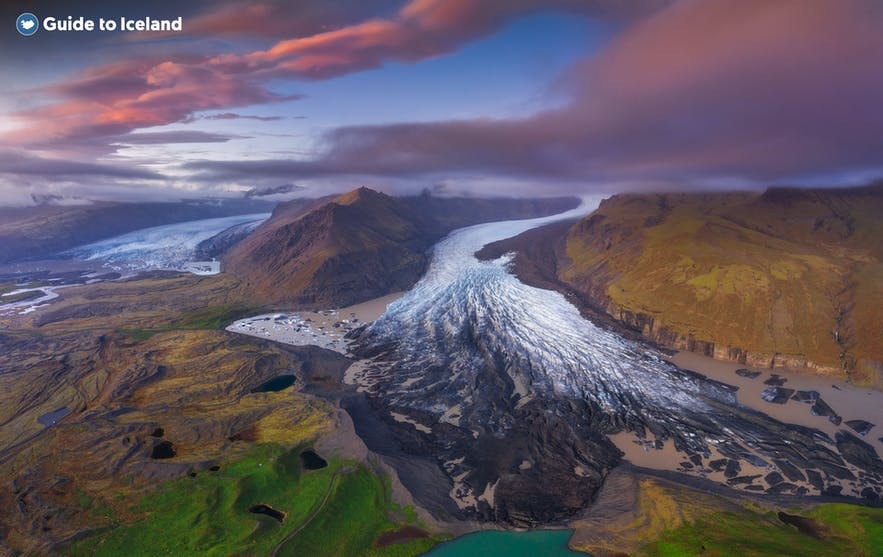
Hiking is one of the best ways to experience the Icelandic countryside. You can get a closer glimpse at the meadows, valleys, streams, and waterfalls that make this island what it is.
The most accessible hiking trails from the capital can be found at the neighboring Mt. Esja, overlooking the city, at a height of 0.57 miles (914 meters). The 2 most popular leisure trails on Mt. Esja are the summits Thverfellshorn, 0.48 miles (780 meters), and Kerholakambur, 0.53 miles (851 meters).
The hike is divided into 4 sections, getting more difficult as the trail gets higher. Those who reach the top have an incredible panorama of Reykjavik and the surrounding Reykjanes Peninsula.
There are still plenty of other great hikes, and you can join guided hiking tours to skip all the hassle of researching and planning the excursion.
It’s important to remember that while the May weather in Iceland is milder, it’s still a bit unpredictable, and it’s recommended that you wear layers when hiking in the elements.
Exploring Glaciers in Iceland in May
Iceland is one of the few countries in Europe that still has glaciers. In fact, more than 11% of the country is covered in ice. Therefore, you might want to explore a glacier while you are in Iceland, and May is a great time to do so.
 Photo from Top-rated Glacier Walk in Skaftafell on Vatnajökull glacier
Photo from Top-rated Glacier Walk in Skaftafell on Vatnajökull glacier
Glacier Hiking in Iceland in May
Another form of hiking to try in Iceland is glacier hiking. A glacier hike or an ice climbing tour can get you up close to these beautiful, unique structures, making it an adventure guaranteed to be the highlight of your trip.
But note that hiking the glaciers without a guide is extremely dangerous and irresponsible. Booking a guided glacier hike means you’ll be accompanied by an experienced professional who knows the paths, techniques, and risks.
With years of training in climbing, hiking, and first aid, it’s highly recommended that you have a guide take you on a glacier hike.
Your guide will know the safest and most spectacular routes, and you’ll be provided with all the equipment necessary to hike the ice cap, such as helmets, snowshoes, trekking poles, and crampons. So all you’ll need to do for hiking glaciers is dress in warm layers and remember to bring your camera.
- See also: Glaciers and Glacier Hiking in Iceland
Snowmobile Tours in Iceland in May
For adrenaline junkies wanting to get out and explore Iceland’s glaciers with extra excitement, booking a glacier snowmobile trip is a great way to blast across these natural wonders. The best glacier for snowmobiling is Langjokull glacier, in the west of Iceland. It’s the second-largest glacier in the country, offering incredible views of the ice valleys and distant Eiriksjokull mountain.
Much like glacier hiking tours, when you book a glacier snowmobiling tour, you’ll be provided with all the necessary equipment and be accompanied by an experienced guide. Be sure to dress in warm, waterproof clothing, and don’t forget your action camera!
Fishing in Iceland in May
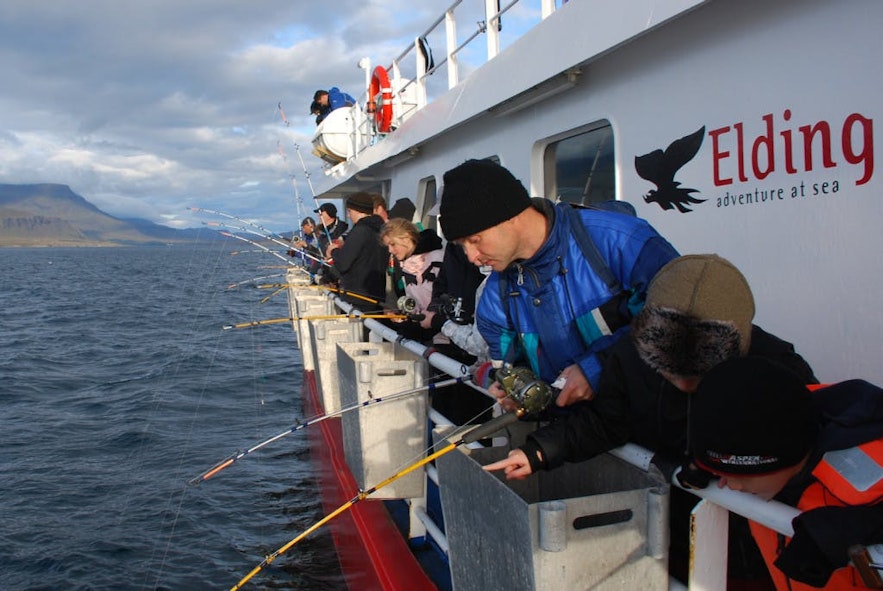
May is one of the better months to fish in Iceland, hitting the season just as it begins.
Iceland has excellent river fishing, but there are also opportunities to fish in the ocean. All fishing in Iceland is private, and fishing times are decided by the landowners. Many of them like to see the fish spend the year in peace. This guarantees the sustainability of the fish population but also protects the land from being trampled or crowded with anglers.
We recommend booking a guided fishing tour in advance to get the best results on your fishing trip. Angling guides know the best spots, techniques, and, most importantly, all the rules and regulations anglers need to follow.
The type of fishing you're interested in will influence the time of year you’d want to arrive. According to Icelandic law, migratory brown trout can be fished between April and October. This is when you can expect rivers to be opened to the public.
Atlantic salmon can also be fished during this period, though arctic char can only be caught from June.
Before fishing in Iceland, you must know that the country has strict fishing laws. For instance, no equipment used abroad may be brought into the country unless it has a certificate of disinfection to prevent water pollution or contamination. All organic live bait is also strictly prohibited.
Make sure you read up about fishing in Iceland before organizing your trip.
Horseback Riding in May in Iceland
Horse riding tours are available year-round, but the warmer temperature in May makes it a more pleasant experience. And you get the opportunity to meet the famous Icelandic horses!
Icelandic horses are the country’s pride and joy and have lived in Iceland ever since the settlement period in the 9th century. Though smaller than other breeds, they are well-known for their friendly nature, reliability, strength, and intelligence. Icelandic horses are also very experienced with visitors, meaning that new riders will find themselves "on good hooves."
After a briefing on the basics of being in the saddle, you'll mount your trusty steed and take off into the beauty of the Icelandic wilderness.
It’s a historic way to travel across Iceland and see farmland, gentle rivers, and peaceful countryside.
For the literature and history buffs out there, Icelandic horses play a major role in Iceland’s folklore and Norse mythology. One notable example is Sleipnir, Odin's eight-legged horse, who is sometimes said to have created the dramatic Asbyrgi Canyon in North Iceland when his giant hoof stomped the ground.
Lava Caving in Iceland in May
Photo from Incredible 1-Hour Lava Tunnel Tour at Raufarholshellir Cave with Transfer from Reykjavik
Lava caving tours are open throughout May and make for a thrilling trip into Iceland’s volcanic, subterranean universe.
Aside from fantastic displays of red, orange, and purple rock, lava caving presents guests with the chance to gain more in-depth insight into Iceland's geology. After all, where else can you touch the fossilized remains of ancient lava flows and learn about the process that created Iceland?
- See also: Caves in Iceland
Most lava caves in Iceland are easily accessible and can be traversed with an average level of physical fitness. However, some caves have very narrow sections you might have to duck, crawl, and climb through. So it might not be suitable if you aren’t comfortable with dark or confined spaces.
Your friendly caving guide will give you all the equipment you'll need—helmets, headlamps, etc.—and will readily answer any question about the history and formation of lava caves. Wear a pair of good hiking boots because the terrain is uneven and often wet with dripping water.
Whale Watching and Bird-Spotting in May in Iceland
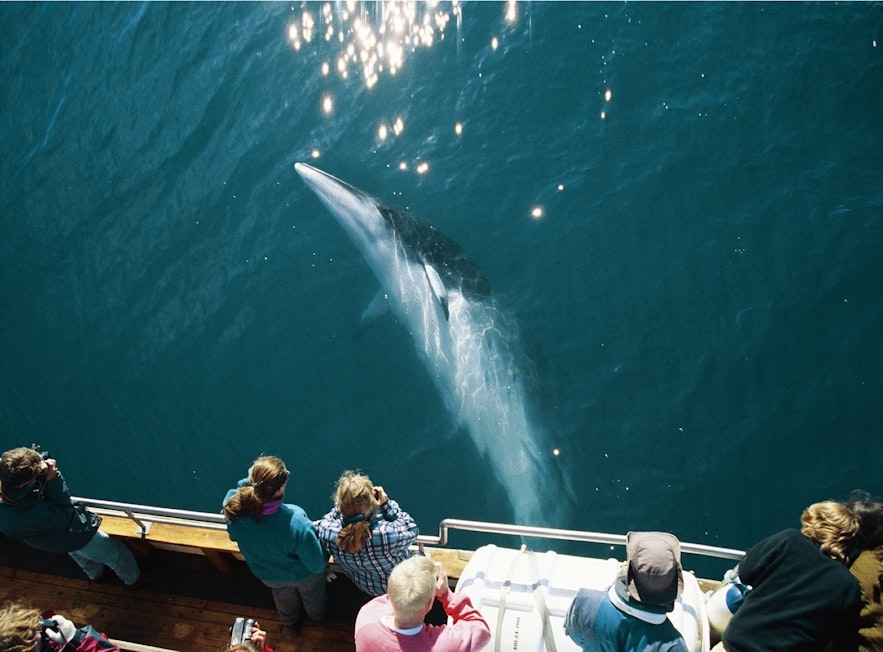
It is the optimum time to explore the many whale-watching tours in Iceland that are available in May. Guests can enjoy a pleasant and relaxing boat trip in the sunshine as they look for signs of these majestic animals.
Iceland has many sea mammal species thriving on its shores: killer whales, harbor porpoises, short-beaked dolphins, sperm whales, humpback whales, and even passing blue whales.
With such a variety of sea life to look out for, it’s almost guaranteed that you will see at least one cetacean species on your trip. Breaching minke whales, a relatively small species, are the most commonly sighted, as are pods of dolphins.
Whale-watching boats in Iceland are fitted with the latest radar technology and are in constant communication with one another, giving you the best chance to see some of these creatures.
The best whale-watching spots in Iceland are Reykjavik in Faxafloi Bay, Europe's whale-watching capital Husavik, and the "Capital of the North," Akureyri. Each port offers a different landscape and a unique opportunity to see Iceland's many whale species.
Bird enthusiasts will also enjoy the seabirds' nest on the nearby cliff sides or sweep across the waves searching for fish.
In certain areas, guests may even be able to spot another of Iceland's iconic residents: the puffin. This adorable creature graces Iceland's shores from early April until September each year.
Puffin Tours in May in Iceland
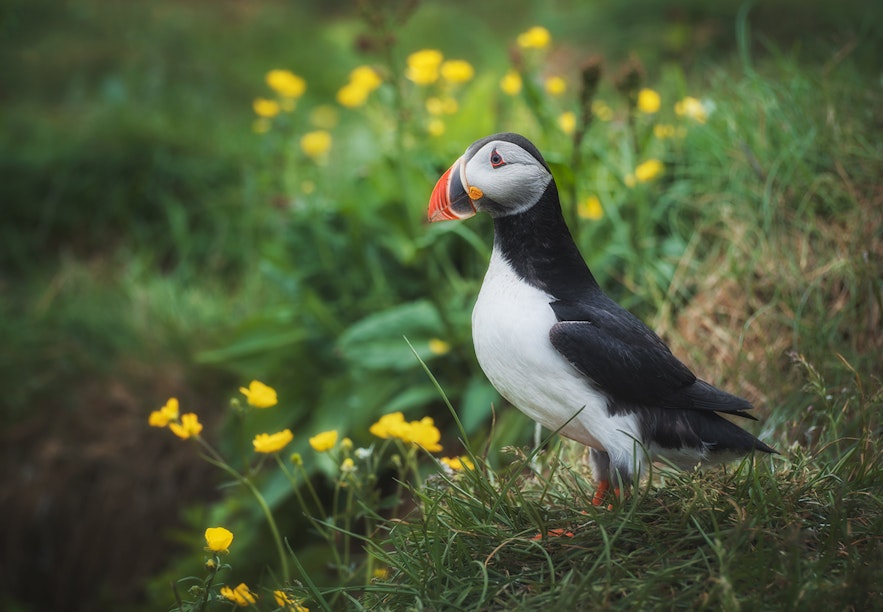
Iceland boasts the largest Atlantic puffin population in the world, flocking to the coastline to nest in the summer months. They arrive in April, so May is the perfect time to spot these adorable 'clowns of the sea.'
The best place to do that is on the South Coast at the Dyrholaey peninsula, which is part of some self-drive tours of the South Coast or the Ring Road.
- See also: Where to Find Puffins in Iceland
Another great place to find them is the rugged Westfjords — the westernmost part of Iceland (and Europe!) — on the cliffside called Latrabjarg.
Latrabjarg is rich in birdlife, and you'll be able to see a range of species. Just be mindful that you are on a cliff.
Many tours offer to take you to see the puffins and whale watching, such as this Whale Watching & Puffin Island Boat Tour from Husavik, there are also tours all over the country that will bring you closer to these curious birds. This puffin-watching tour from Reykjavik is a perfect activity for animal lovers and families alike.
Can you see the Northern Lights in Iceland in May?
When you visit Iceland in May, the one thing you can’t do is see the northern lights.
The aurora borealis is a solar phenomenon that can only be seen with clear night skies during solar activity. Due to the short (or nearly non-existent) nights and limited darkness, it’s impossible to see the northern lights in May in Iceland.
But for those that have never seen the sun shining bright at midnight, turning the sky pink and purple, it almost makes up for not being able to see the aurora!
Best things to do in Reykjavik in May
Iceland's capital city is a great place to set up as your base of operations for your adventures. With plenty of hotels and access to plenty of tours starting from Reykjavik, you can rest up and easily plan your activities. As one of Europe’s smallest capital cities, it’s easy to explore on foot, especially in May, as the weather is more accommodating for walking.
Here are some top local recommendations for things to do in and around Reykjavik during your visit in May.
The Golden Circle tour from Reykjavik in May
May is a little quieter in Iceland because summer tourism hasn’t really kicked in yet. This makes it a perfect time to book tours without worrying about the crowds. The Golden Circle is one of Iceland’s most popular attractions, with plenty of trips heading out of Reykjavik to take you to see these amazing sights.
Geothermal spas near Reykjavik open in May
Iceland’s geothermal spas are a wonderful way to relax and soak in the beauty of the country’s natural landscapes. The Sky Lagoon and Blue Lagoon are two of Iceland’s most popular spas that take advantage of the island’s natural hot springs. The recently opened Hvammsvik Hot Springs is also a great geothermal spa by the ocean, only a short drive from Reykjavik.
In addition to the many geothermal spas, you can also visit some of the many public swimming pools in Reykjavik, which usually have a steam room, sauna, and multiple hot tubs.
The Reykjavik Food Tour in May
The Reykjavik Food Tour allows you to experience Iceland’s food and history while exploring its capital city all in one sitting! With ten local cuisines on the menu, you’ll get a guided tour around the city, stopping to fuel on local delicacies along the way.
Hotels in Reykjavik in May
There are over 600 hotels in Reykjavik catering to all tastes and budgets. For the most cost-effective, consider the Skuggi Hotel and the Center Hotel on Laugavegur street. Both of these affordable, comfortable hotels are conveniently located in the center of Reykjavik, giving you easy access to amenities, restaurants, and everything else the city has to offer.
If you want to splash out on luxury accommodation for your visit, try the boutique Sand Hotel for a stylish, sophisticated stay in Reykjavik.
Hotels are much cheaper in May than in June, so take advantage of the lower prices before the peak travel season starts!
Driving around Iceland in May
May is an excellent time of year to see Iceland by road. With only a very small chance of encountering some snow on roads in the northern part of the island, you can traverse the whole country easily. This makes it a perfect way to create your own custom adventure and be sure to see and do all the things you want at your leisure.
Can I rent a car in Iceland in May?
Yes, renting a car and driving around Iceland in May is recommended. Take a look at the wide selection of rental vehicles at Iceland's largest car rental marketplace. If you want to take advantage of Iceland’s open roads and get out of the city, it’s recommended that you hire a four-wheel-drive vehicle like an SUV or mini truck. This way, you have plenty of room for luggage and the capability to manage most terrains.
Can you drive the Ring Road of Iceland in May?
In May, there will be no ice on the roads, so you can feel free to drive the whole circle of Iceland without worrying about slippery roads. The famous Ring Road is an 828-mile (1,332 kilometers) road that encircles the whole country and is a great way to see the variety of Iceland's regions in one road trip. It’s a paved single-lane road with very little traffic that gives you access to all the sights you would want to see, except the Westfjords and Snaefellsnes peninsula.

Can you drive to explore the Golden Circle in May?
In May, you can easily reach the Golden Circle, both on tours and by driving there yourself. One of Iceland’s most famous attractions is known as the Golden Circle. This 186 miles (300 kilometers) route takes you to three iconic places: Geysir Geothermal Area, Gullfoss Waterfall, and Thingvellir National Park.
May is an ideal time to visit these incredible places as the longer daylight hours give you plenty of time to take them in full without being too crowded by the summer tourist groups.
While you can book many excellent Golden Circle tours, it’s worth taking advantage of the freedom that comes with self-driving Iceland to include this on your itinerary when planning your trip.
Read our comprehensive guide to driving in Iceland for all the information you’ll need about driving in Iceland, like parking, age restrictions, and local road rules, as well as the best tips on how to stay safe while exploring the country by car.
Events in Iceland in May
For those traveling to Iceland in May, there are also several festivals that are the highlights of Icelandic and international music and art. May also see religious celebrations, historical festivals, and even a commemoration day for the Icelandic horse.
Ascension Day (Public Holiday)
Ascension Day is one of the oldest Christian holidays, celebrated 40 days after Easter to commemorate Jesus' ascension to heaven.
Ascension Day is a public holiday in Iceland. Children are given the day off from school, and most workplaces are closed. Icelanders tend to spend the day at home with their family and dine on traditional cuisine.
Visitors interested in religion—or architecture—can maximize this day by visiting some of Iceland’s most iconic churches.
Famous churches in Reykjavik
- The modernist Lutheran Hallgrimskirkja church.
- The 1899 green-roofed church, Frikirkjan in Reykjavik by the city pond, Tjornin
- Landakotskirkja (Landakot’s Church), formally referred to as Basilika Krists Konungs (The Basilica of Christ the King), is the designated cathedral for the Catholic Church of Iceland.
- Akureyrarkirkja church is the Lutheran Church of Akureyri, instantly recognizable by its cuboid steeples, its clock face centerpiece, and the staircases leading up to its entrance.
- The iconic black church of Budir, located on the beautiful Snaefellsnes peninsula
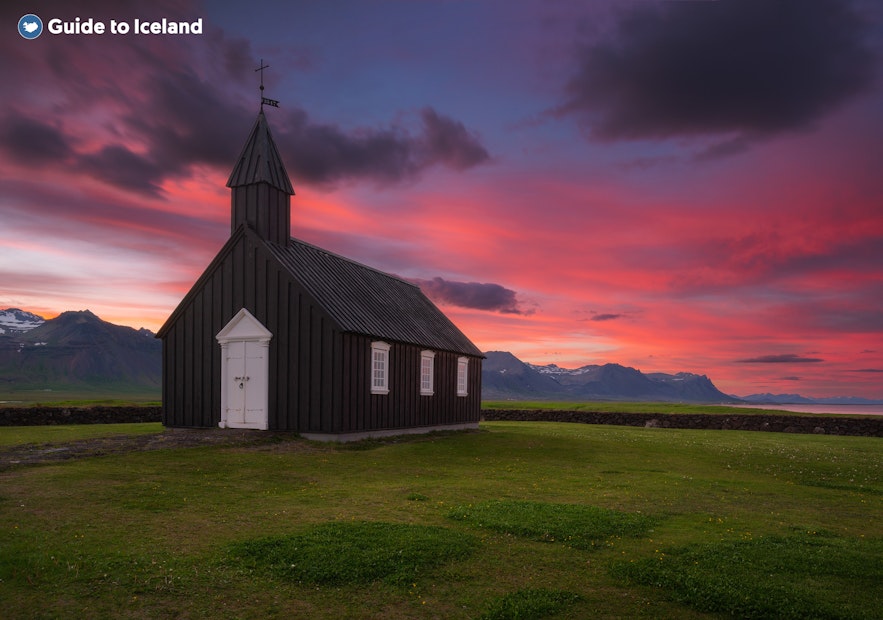
RAFLOST: Icelandic Festival of Electronic Arts
Since 2007, RAFLOST has been the pioneering festival for electronic artists—computers, dance, music, games, and poetry. Over the last decade, the festival has become a force of nature, attracting artists from across the world to experiment and participate in this rare, collective experience.
Held in Reykjavik in May of each year, RAFLOST collaborates with the Ministry of Education, Science and Culture, and the Icelandic Academy of Arts to bring together all those impassioned by the artistic potential of electronic art.
In the past, electronic music giants like Morton Subotnick, Todor Todoroff, and Mikael Fernstrom have all wowed audiences with their festival performances at RAFLOST.
International Day of the Icelandic Horse
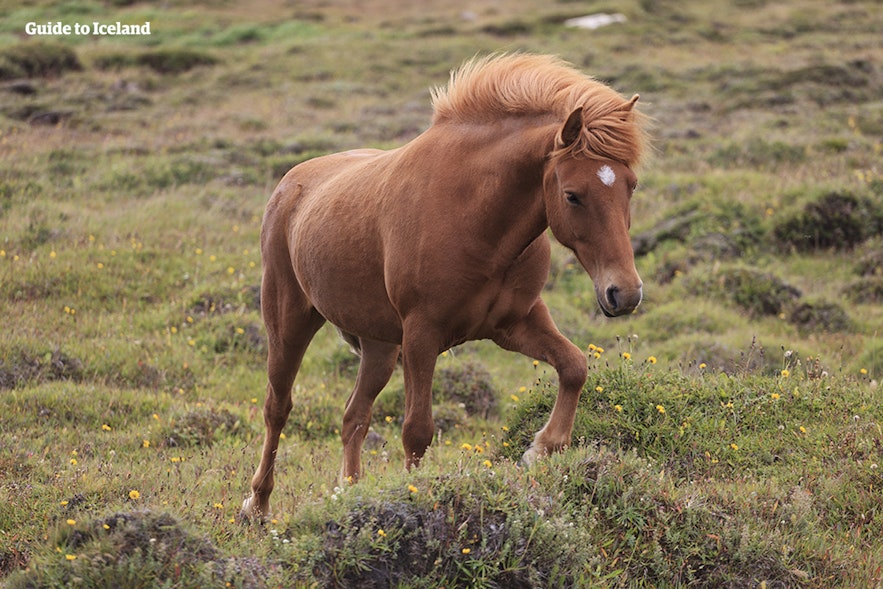
The International Day of the Icelandic Horse started as a collaboration between the Icelandic Equestrian Association and the Horses of Iceland marketing initiative.
The Icelandic horse is a friendly steed that has been a part of Iceland's history since the 9th century, when the first settlers arrived from Scandinavia.
It's the only breed of horse that exists in Iceland and is highly protected, meaning no horses of any breed can be imported into the country.
It's a good day to get to know these majestic horses, even when staying in Reykjavik, for example, this 2.5-hour Horse Riding Tour of the Volcanic Raudholar Countryside with a transfer from Reykjavik.
The festival is a joint effort between stable owners and enthusiastic members of the Icelandic horse community. Open days are held at participating stables across the country for friends and families to meet the Icelandic horse breed up close.
May First (Labor Day)
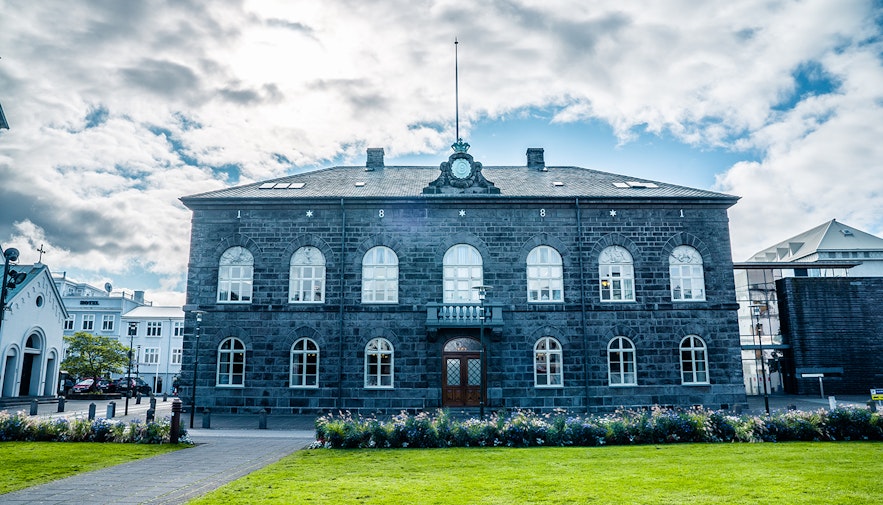 Falling on the same day as the International Day of the Icelandic Horse, May 1 is a public holiday. Many know it as 'Labor Day,’ but in Iceland, it’s most often called "May First" (Fyrsti maí) as the day has become synonymous with labor.
Falling on the same day as the International Day of the Icelandic Horse, May 1 is a public holiday. Many know it as 'Labor Day,’ but in Iceland, it’s most often called "May First" (Fyrsti maí) as the day has become synonymous with labor.
May Day in Iceland has become an unofficial day of protest in Iceland. Many carry banners and signs to the streets, making their demands and concerns clear.
The first protest on May 1 in Iceland's history was in 1923, making it a 100-year-old tradition in 2023.
Although there isn't a unified subject, many Icelanders argue for higher wages, shorter work days and workweeks, and flexible office hours.
In previous years, protesters have gathered together at Hlemmur Bus Station before marching down the main street in downtown Reykjavik, Laugavegur. Finally, the procession ends at Austurvollur Square by the Parliament of Iceland (pictured above), where some speeches are held, and cakes and coffees are supplied by representatives of Iceland's trade unions.
Should You Visit Iceland in May, April, or June?
May is an excellent period for travelers hoping to get in as many sights and activities as possible without the crowds. While the midnight sun is not at its peak, May is a shoulder season that is friendly to visitors’ budgets. If you plan on hiking, the Icelandic Highlands region is not open until June. The National Day of Iceland is also in June. So, choosing between the two months depends on the focus of your trip and your personal preference.
May is ideal for the best value for money, but if you want to see the northern lights, you should visit in April.
Recommended travel itineraries for May
The weather in May in Iceland is better, and many roads are reopening, making road trips across the country possible again.
If you're stuck for ideas, check out the following itineraries—the perfect inspiration for your May holiday to Iceland.
-
For those who want to see the whole of Iceland, this 14-day self-drive tour around Iceland and the Westfjords is the most comprehensive route.
-
A little shorter and skipping the more remote Westfjord is this 12-day self-drive complete Ring Road package.
-
There is a one-week summer self-drive tour that covers the Ring Road of Iceland & Golden Circle if you are short on time and want to see the highlights.
-
The early May Iceland weather can still be cold and icy, so this scenic 5-day summer vacation package of Iceland with Jokulsarlon Glacier Lagoon might be better.
-
Alternatively, a shorter guided 3 in 1 summer tour taking you to Snaefellsnes peninsula, Jokulsarlon glacier lake, and Golden Circle in 2 days may work well.
Do you want to visit Iceland in May? What are you planning to see while visiting? If you have visited Iceland in May, please tell us what were your favorite places to visit!
Other interesting articles
Visiting Iceland in January | The Ultimate Guide
Learn everything there is to know about visiting Iceland in January. It's one of the best months for experiencing many of Iceland's top attractions, such as ice caving, glacier hiking, and aurora hu...Read more
Complete Guide to the 2022 Eruption of Fagradalsfjall Volcano
Learn everything you need to know about the 2022 Fagradalsfjall volcano eruption in Iceland! How strong was the eruption? Can you visit the volcano now? How do you get there? Was the eruption danger...Read morePhotography in Iceland
Why is Iceland the perfect destination for photographers? What makes photography in Iceland so unique? When is the best time of the year to take photographs in Iceland? Continue reading to learn abo...Read more

Download Iceland’s biggest travel marketplace to your phone to manage your entire trip in one place
Scan this QR code with your phone camera and press the link that appears to add Iceland’s biggest travel marketplace into your pocket. Enter your phone number or email address to receive an SMS or email with the download link.

